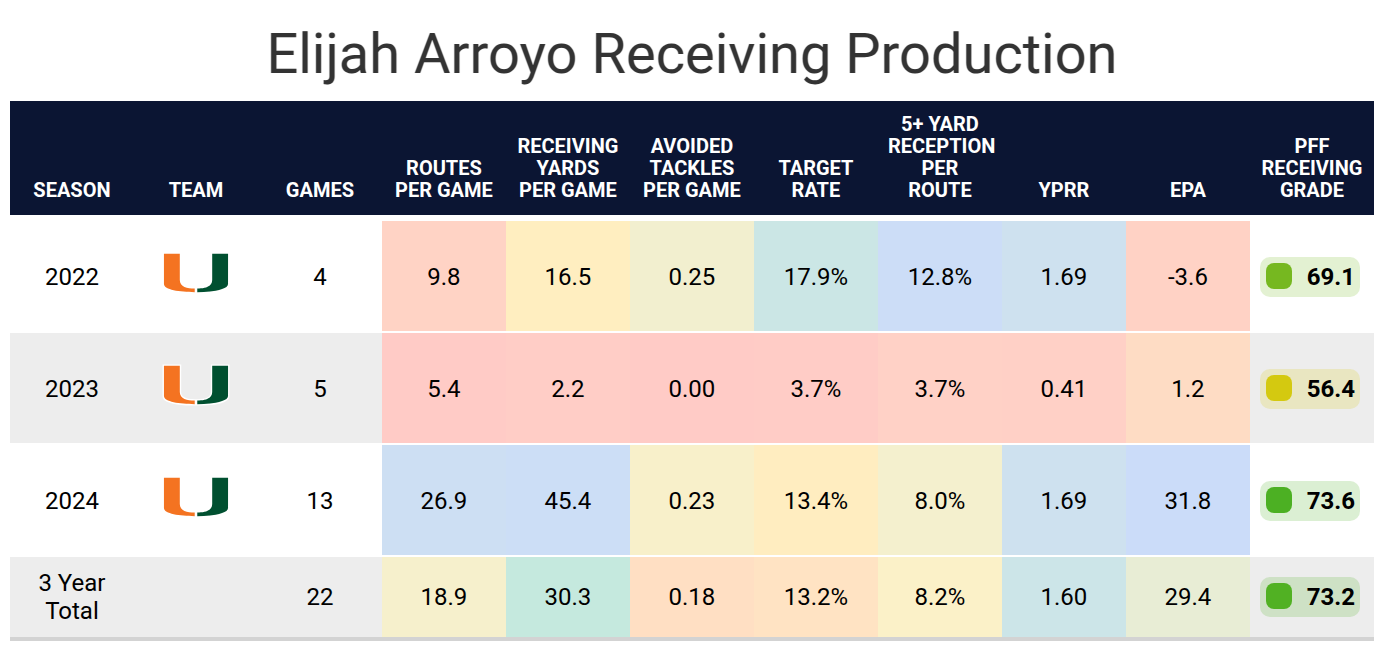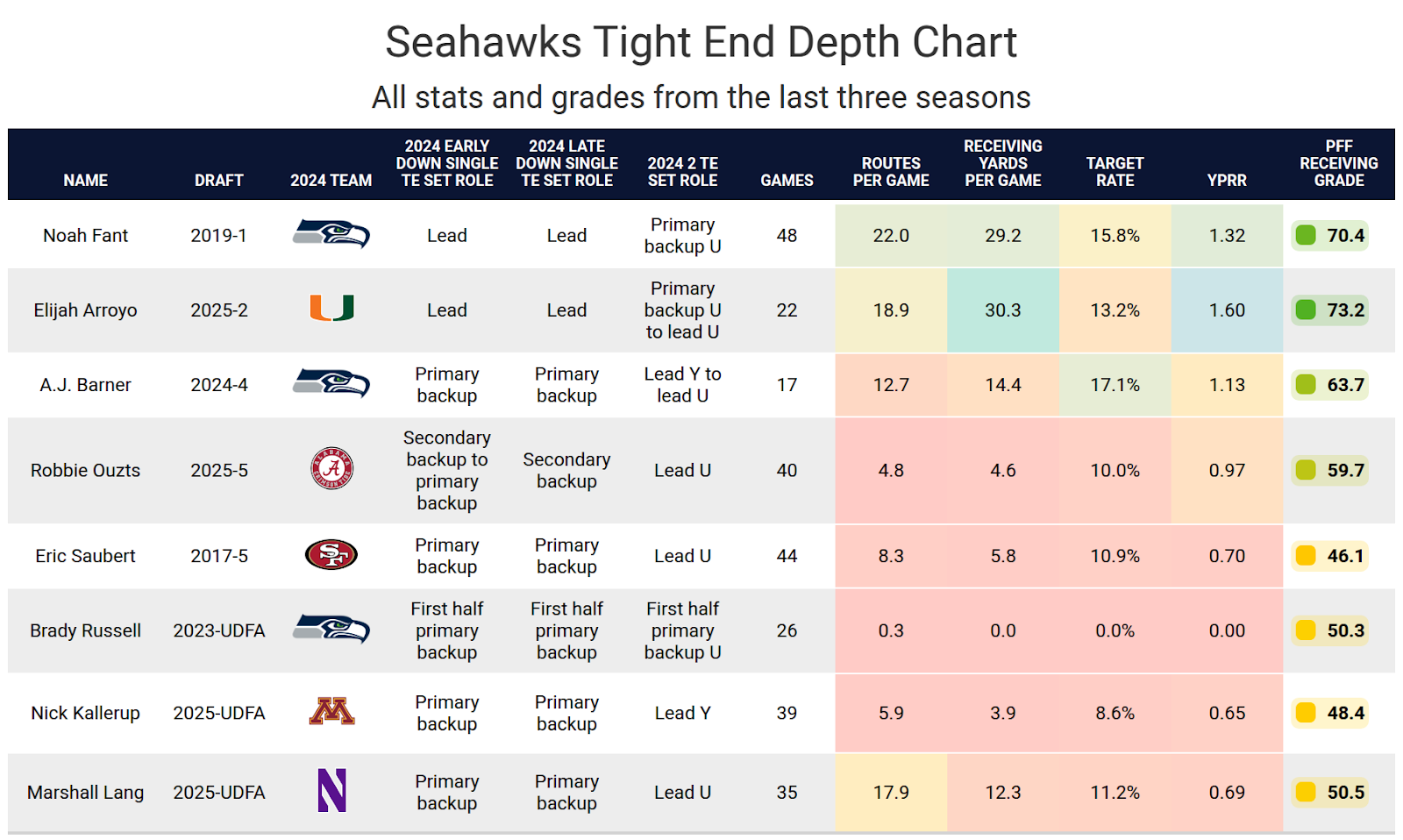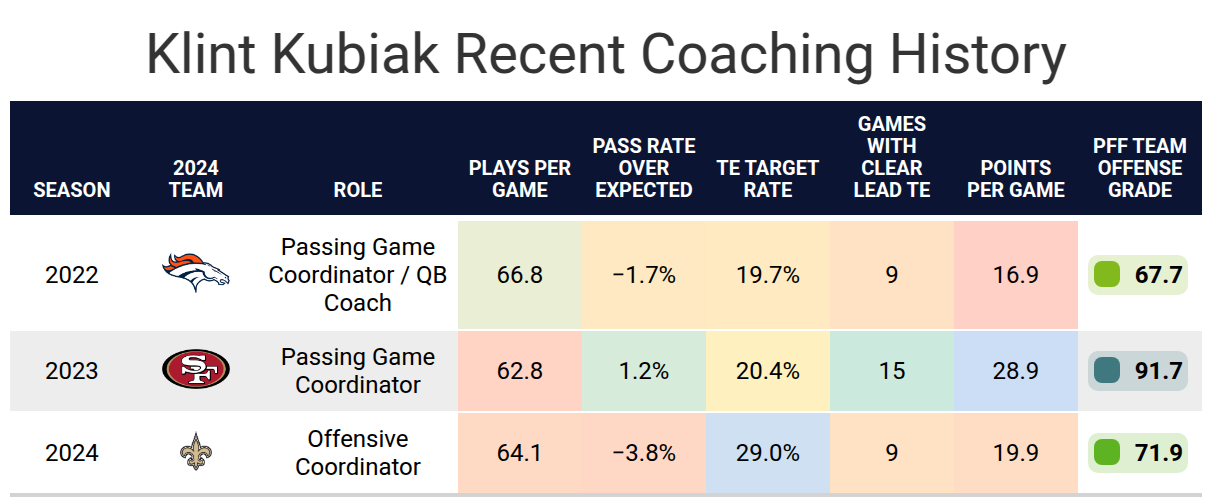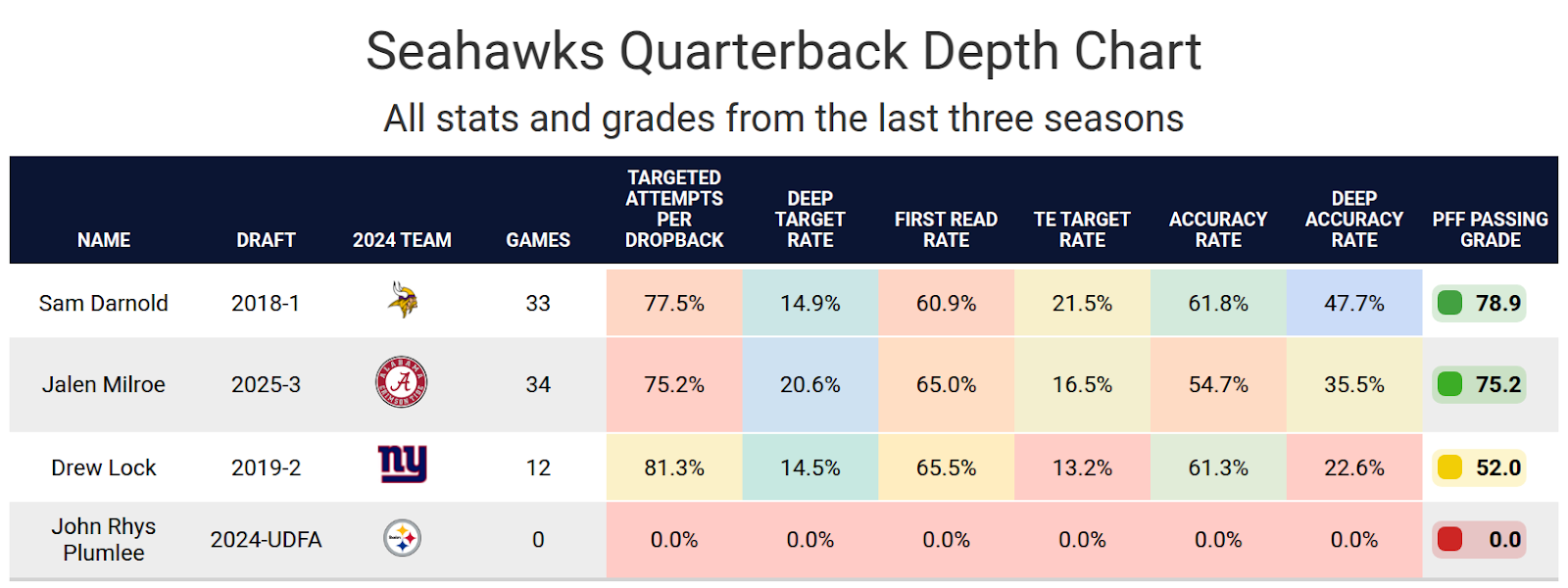- Elijah Arroyo is a speedy tight end: While Arroyo didn’t have a lot of production over his entire college career, he showed enough big-play ability to get excited about what he could do in the NFL.
- His offensive coordinator has experience with rookie tight ends: Arroyo’s closest comparison is Greg Dulcich, a tight end that new Seattle Seahawks offensive coordinator Klint Kubiak coached during Dulcich’s breakout rookie season with the Denver Broncos
- Subscribe to PFF+: Get access to player grades, PFF Premium Stats, fantasy football rankings, all of the PFF fantasy draft research tools and more!
Estimated Reading Time: 5 minutes
PFF’s Fantasy Football Player Profile series delivers the most in-depth fantasy football analysis available for the 2025 season.
Using PFF’s exclusive data, we evaluate player performance, competition for touches and how teammates and coaching staffs will impact each player's fantasy football outlook.
Last updated: 7:15 a.m. Friday, May 9
Click here for more draft tools:
NFL Draft Big Board | Mock Draft Simulator | NCAA Premium Stats
2025 PFF Draft Guide | Mock Draft Hub | Prospect Data Profiles
Draft Position Rankings
Player performance
Elijah Arroyo started his collegiate career in 2021 as Miami’s No. 2 tight end behind Will Mallory. In 2022, Arroyo received a boost in playing time and had a better receiving grade than Mallory over the first four weeks. An ACL tear cut his 2022 short, and he missed most of 2023. His only true season with a significant role was last season.
Arroyo only seemed like an average tight end for most of the season, but he played exceptionally well in his last four games, finishing with an 82.0 receiving grade. He averaged 2.47 yards per route run in those games, including five explosive plays and 18 total receptions for 269 yards. Throughout his time, he played very well against zone defenses but struggled more against man coverages. He also wasn't great in contested-catch situations. His separation rate is only in the 76th percentile, the lowest among those who were expected to get drafted on the first two days of the draft.
Anyone drafting Arroyo will rely more on his traits than his college production. While Arroyo didn’t work out at the combine, he is among the fastest draft-eligible tight ends in recent seasons based on PFF's tracking data. The only tight ends drafted since 2016 who have been faster are Brock Bowers, Greg Dulcich and Jaheim Bell. Our draft guide states, “His movement skills are above average, from his straight-line speed to how quickly he flips his hips when running routes and earning yards after the catch.”


Projected role
Arroyo joins a crowded Seahawks tight end room. Seattle used a three-man tight end room last season. Noah Fant and AJ Barner played the majority of snaps, while Pharaoh Brown also played significantly as a blocker. Seattle opted not to re-sign Brown and instead added Saubert, who has also been primarily a blocking tight end. In the draft, they added Arroyo, as well as Robbie Outzts, who played tight end in college but is expected to be a fullback for the Seahawks.
Typically, teams that have a fullback only roster three tight ends, so one of Fant, Barner or Saubert is unlikely to make the roster. That tight end will probably be Saubert, but there is a chance it could be Fant. The Seahawks have plenty of cap space, but he’s in the last season of his contract, and Seattle would save $8.9 million in cap space by moving on from him.
Arroyo’s fantasy value in his first year will depend entirely on whether Fant remains on the roster. If the Seahawks retain Fant, he will likely play significant snaps. It might not be enough for Fant to be fantasy-relevant, but it will be enough to prevent everyone else from being fantasy-relevant. If Fant is off the roster, then Arroyo has a chance to be an immediate starter and a fine sleeper option. Regardless, we can expect Arroyo to be the Seahawks' lead tight end in 2026 and beyond.


Impact of teammates
Kubiak has been on four different coaching staffs in each of the last four seasons, with a variety of tight end rotations. In 2023, he was the San Francisco 49ers‘ passing game coordinator for George Kittle, who was an every-down tight end and led the team in passing yards. In 2021, he was the offensive coordinator for the Minnesota Vikings, where Tyler Conklin played 81% of the team's offensive snaps but finished 20th in fantasy points per game. Last season, Foster Moreau and Juwan Johnson split time in an offense that heavily utilized 12 personnel, leading both to play between 60-70% of their team's snaps.
Most notable was his time with the Denver Broncos, where third-round rookie Greg Dulcich emerged as the lead receiving tight end and played 75% of the team's offensive snaps during the 10 games he was healthy. He was held to 11 yards or less in three of those games but also reached 85-plus yards twice. Dulcich was our player comparison for Arroyo in our draft guide. It’s difficult to tell what tight end rotation the Seahawks will use, but a lot will depend on how much Fant or Arroyo can impress the new coaching staff.
Arroyo will be catching passes from Sam Darnold. In Minnesota, he threw deep more than the usual quarterback and was one of the most accurate quarterbacks on deep passes. This could be good news for Arroyo, who posted a very high average depth of target last season, which included a high deep pass rate.


Bottom line
Arroyo showed sparks of talent at Miami. He goes to a Seattle Seahawks team with a chance at coach, quarterback, multiple wide receivers and an incumbent veteran tight end who might not be on the team much longer. The several moving parts lead to a wide range of outcomes for Arroyo as a rookie, but one of those scenarios includes him being a starter, a big part of the offense and a borderline fantasy starter.
Footnotes
- Statistics in tables and charts were chosen based on their ability to predict future fantasy performance on a per-game or per-opportunity basis or to describe the player relative to others at the same position.
- “Opportunities” are defined as passing dropbacks, rushing attempts and routes run as a receiver.
- Numbers are provided either by season or based on the past three years. For rookies, only college statistics are included. For non-rookies, only NFL statistics are considered, regardless of whether they played in college within the previous three years.
- As college competition is easier than NFL competition, most rookies are likely to see a decline from their historical numbers.
- Only FBS data is considered for college players and comparisons.
- Kneel-downs are removed from rushing data to provide cleaner quarterback rushing rate statistics.
- The table colors in this article range from blue (indicating good/high) to red (indicating bad/low).
- All percentiles and color codings compare the given player to others with a high sample of opportunities. Generally, the cutoff is one-third of the possible opportunities in the sample. If a player does not meet the threshold, they are still included in the comparison, though their results may appear better or worse than expected due to the smaller, less predictive sample size.
- Information on utilization classifications and their importance can be found here for running backs, wide receivers and tight ends.



 © 2025 PFF - all rights reserved.
© 2025 PFF - all rights reserved.